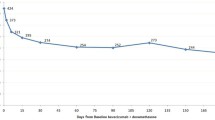Abstract
Background
The purpose of the study was to determine the efficacy and safety of intravitreal triamcinolone acetonide (TA) in chronic diabetic macular oedema with severe hard exudates.
Methods
This prospective, interventional consecutive case series study consisted of 33 eyes of 28 patients with chronic diabetic macular oedema and severe foveal hard exudates who received an intravitreal injection of 4 mg of TA. The patients were divided into two groups according to the type of foveal hard exudates: group I, plaque-like (17 eyes) and group II, dot-like scattered hard exudates (16 eyes). The results of both groups, evaluated by colour fundus photography and fluorescein angiography, were compared and complications were recorded.
Results
All patients completed at least 6 months of follow-up. In all eyes, the hard exudates were completely resolved (24% in group I and 50% in group II) or decreased (76% in group I and 50% in group II). In group I, the mean diameter of the exudates plaques significantly decreased from 5.5±3.8 mm2 in the pre-treatment period to 2.2±2.7 mm2 at the end of the follow-up period. There was no recurrence of the hard exudates in either of the groups. The mean ± SD visual acuity (VA) improved from 0.07±2.5 at the baseline to a maximum of 0.09±2.1 lines in group I (P<0.01) and from 0.13±3.9 to a maximum of 0.27±2.7 lines in group II (P<0.01). The mean VA improvement in group II was better than group I (3.2±2.5 vs. 1.4±1.0 lines, P<0.05). Intraocular pressure exceeded 21 mmHg in 10 eyes (30%), which was then controlled by topical medication. Three eyes (9%) exhibited signs of subcapsular cataract progression.
Conclusions
Intravitreal TA appears to be a valuable treatment in chronic diabetic macular oedema with severe foveal hard exudates. In all eyes in this study the hard exudates were completely resolved or decreased, and the mean VA improved significantly in both groups. However, the VA improvement was significantly worse in eyes with plaque-like exudates suggesting the possible value of earlier treatment. Further studies would enable the assessment of the universal effectiveness of this treatment.




Similar content being viewed by others
References
Antonetti DA, Wolpert EB, DeMaio L, Harhaj NS, Scaduto RC Jr (2002) Hydrocortisone decreases retinal endothelial cell water and solute flux coincident with increased content and decreased phosphorylation of occludin. J Neurochem 80:667–777
Bakri SJ, Beer PM (2004) Intravitreal triamcinolone injection for diabetic macular edema: a clinical and fluorescein angiographic case series. Can J Ophthalmol 39:755–760
Bresnick GH (1983) Diabetic maculopathy: a critical review highlighting diffuse macular edema. Ophthalmology 90:1301–1317
Ciardella AP, Klancnik J, Schiff W, Barile G, Langton K, Chang S (2004) Intravitreal triamcinolone for the treatment of refractory diabetic macular oedema with hard exudates: an optical coherence tomography study. Br J Ophthalmol 88:1131–1136
Fisher S, Renz D, Schaper W, Karliczek GF (2001) In vitro effects of dexamethasone on hypoxia-induced permeability and expression of vascular endothelial growth factor. Eur J Pharmacol 411:231–243
Fong DS, Segal PP, Myers F, Ferris FL, Hubbard LD, Davis MD (1997) Subretinal fibrosis in diabetic macular edema. ETDRS report 23. Early Treatment Diabetic Retinopathy Study Research Group. Arch Ophthalmol 115:873–877
Jonas JB, Degenring RF, Kamppeter BA, Kreissig I, Akkoyun I (2004) Duration of the effect of intravitreal triamcinolone acetonide as treatment for diffuse diabetic macular edema. Am J Ophthalmol 138:158–160
Jonas JB, Kreissig I, Sofker A, Degenring RF (2003) Intravitreal injection of triamcinolone for diffuse diabetic macular edema. Arch Ophthalmol 121:57–61
Jonas JB, Sofker A (2001) Intraocular injection of crystalline cortisone as adjunctive treatment of diabetic macular edema. Am J Ophthalmol 132:425–427
Klein R, Klein BE, Moss SE, Davis MD, DeMets DL (1984) The Wisconsin Epidemiologic Study of Diabetic Retinopathy. IV. Diabetic macular edema. Ophthalmology 91:1464–1474
Levine RM, Rasmussen JE (1983) Intralesional corticosteroids in the treatment of nodulocystic acne. Arch Dermatol 119:480–481
Martidis A, Duker JS, Greenberg PB, Rogers AH, Puliafito CA, Reichel E, Baumal C (2002) Intravitreal triamcinolone for refractory diabetic macular edema. Ophthalmology 109:920–927
Massin P, Audren F, Haouchine B, Erginay A, Bergmann JF, Benosman R, Caulin C, Gaudric A (2004) Intravitreal triamcinolone acetonide for diabetic diffuse macular edema: preliminary results of a prospective controlled trial. Ophthalmology 111:218–224
Mohan K, Dhir SP, Munjal VP, Jain IS (1986) The use of intralesional steroids in the treatment of chalazion. Ann Ophthalmol 18:158–160
Otani T, Kishi S (2001) Tomographic findings of foveal hard exudates in diabetic macular edema. Am J Ophthalmol 131:50–54
Ozkiris A, Evereklioglu C, Erkilic K, Tamcelik N, Mirza E (2004) Intravitreal triamcinolone acetonide injection as primary treatment for diabetic macular edema. Eur J Ophthalmol 14:543–549
Sakuraba T, Suzuki Y, Mizutani H, Nakazawa M (2000) Visual improvement after removal of submacular exudates in patients with diabetic maculopathy. Ophthalmic Surg Lasers 31:287–291
Takagi H, Otani A, Kiryu J, Ogura Y (1999) New surgical approach for removing massive foveal hard exudates in diabetic macular edema. Ophthalmology 106:249–256
Takaya K, Suzuki Y, Mizutani H, Sakuraba T, Nakazawa M (2004) Long-term results of vitrectomy for removal of submacular hard exudates in patients with diabetic maculopathy. Retina 24:23–29
Yang CM (2000) Surgical treatment for severe diabetic macular edema with massive hard exudates. Retina 20:121–125
Author information
Authors and Affiliations
Corresponding author
Rights and permissions
About this article
Cite this article
Avci, R., Kaderli, B. Intravitreal triamcinolone injection for chronic diabetic macular oedema with severe hard exudates. Graefe's Arch Clin Exp Ophthalmo 244, 28–35 (2006). https://doi.org/10.1007/s00417-005-0069-5
Received:
Revised:
Accepted:
Published:
Issue Date:
DOI: https://doi.org/10.1007/s00417-005-0069-5




